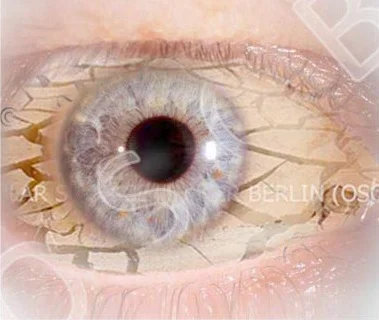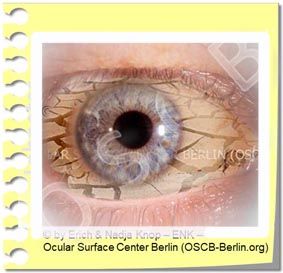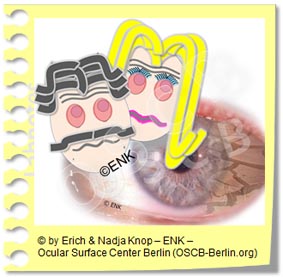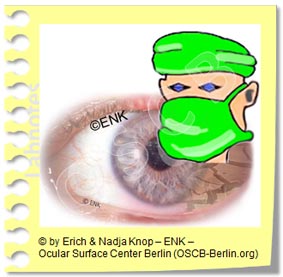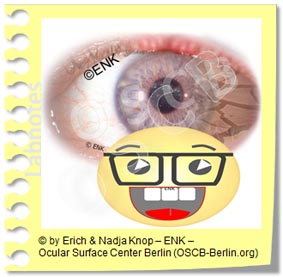CHAPTERS: [ HOME-Page ] [ FACTS & INFORMATION ] [ RECOGNIZE & TREAT ]
FACTS about Dry Eye Disease
On this page you will find information on
Some facts about Dry Eye Disease that is a chronic irritative condition of the ocular surface with many annoying symptoms
Dry Eye Disease is based on a defective wetting of the eye that is caused by a lack of tear production or by a lack in the formation of an even tear film
A multitude of risk factors can disturb the important tear film and thus promote ocular surface dryness
When dry eyes become chronic, they turn into dry eye disease
Dry Eye Disease may include inflammatory reactions that give rise to vicious circles of self-aggravation if no sufficient treatment is applied
Prevention and Treatment of dry eyes reaches from useful home remedies to elaborated physical and anti-inflammatory medications
Facts
Dry Eye Disease (also known as Keratoconjunctivitis sicca - Sicca Syndrome etc.)
The surface of the eye (ocular surface) including the eyelids.
is considered as the most common disease condition in ophthalmology worldwide - because the moisture of the surface of the eye is a prerequisite for its health.
shows chronic damage to the surface of the eye with annoying sensations and irritation.
is typically caused by any lack of the tear film that keeps the ocular surface moist
this leads to tissue damage and corresponding complaints.
Complaints
The Symptoms in dry eye disease are relatively simple to explain
… because they are caused by a disturbance of the moist tear film with the resulting damage and thus irritation of the tissue.
Since the tear film not only provides moisture but also ensures clear vision, dry eye disease can also cause visual disturbances.
The symptoms of dry eyes (please see image) are manifold and often quite unspecific at first, so that the diagnosis can be difficult for the patient and doctor:
Some annoying symptoms of dry eyes are schematically shown here, such as blurred vision, dryness, redness, stinging sensation, burning eyes - here is more information on typical symptoms.
Irritation can lead to:
feeling of dryness, itchiness and redness
sticky eyes
foreign body sensation, gritty sandy sensation
'tired eyes' and 'heavy eyelids'
burning, stinging and pain
occasionally wet eyes and heavy lacrimation
Visual disturbances often appear as:
blurred vision
fluctuating visual acuity
glare sensitivity and photophobia
Many factors can influence the course of dry eye disease - they can be summarized as causative factors and risk factors.
Causative factors
CAUSES for the lack/ deficiency of the tear film are a lack of tear fluid production by the glands and/ or a disturbance in the formation of the tear film from the tear fluid by the eyelid blink.
The tear film on the ocular surface needs an oil layer (yellow, left side of the image) on top of the aqueous tears (light blue, in the middle). The oil retards rapid evaporation of the water. A lack of oil increases evaporation (light blue undulated arrows, right side) with subsequent irritation and damage of the delicate tissue (pink stain on the tissue, right side) that cause annoying irritant symptoms.
A lack of water due to low production of aqueous tears by the lacrimal gland is only rarely the first cause of a dry eye - contrary to what one might think.
in fact, in most patients a lack of oil on the surface of the tear film is the initial cause of a dry eye
due to the increased evaporation of the aqueous tears (please see image)
… oil deficiency is typically caused by a dysfunction of the meibomian oil-glands (MGD) inside the eyelids
and / or
(2) Lack of tear film formation from the existing tears through the eyelid blink
The eyelids and the eyelid blink are as important for the health of the eye as the tears.
Only a thin and even film of tears on the eye guarantees
constant wetting and thus health
as well as perfect visual acuity
The normal eyelid blink (please see image) spreads the existing tears into the tear film over the surface of the eye.
If blinking is disturbed, the surface of the eye becomes dry and vision becomes blurred: e.g. by
rare blinking during concentrated visual work (e.g. screen work, driving a car, watching television)
incomplete eyelid blinking/ nervous blinking
changes in the shape of the eyelids that may interfere with the normal distribution of the tear film
=> here is more information on basic causative factors for dry eyes
Risk factors
Many risk factors have a negative impact on eye health and favor dry eyes
Many desiccating environmental factors come together in office work and may cause "office eye“.
Some risk factors are inside the body …
aging processes with advancing age
hormones and their changes (especially sex hormones)
excessive cornification of the skin on the margin of the eyelids
various medications can promote a dry eye
many risk factors are desiccating environmental factors - at home and in working environments
desiccating environmental factors (drafts, wind, blowers, fans, dry air, air conditioners) - they can often be improved or eliminated
many negative factors come together in office work and can lead to the so-called "office eye" … in case of extensive computer gaming this is known as “gamer´s eye”
=> here is more information about Risk Factors for Dry Eyes
=> here is more information about the most frequent Risk Factors and ´Home Remedies´ to improve them
Self aggravation
When dry eyes become a chronic condition, they turn into dry eye disease. The worsening of dry eyes into chronic dry eye disease is governed by vicious circles of self-aggravation that occur if no effective treatment is applied.
Dry eyes tends to worsen without adequate treatment
through many self-reinforcing vicious circles
inflammatory reactions are an important factor in increasing the disease
this requires timely and specific therapy by the ophthalmologist
Therapy
Many simple things can be helpful in preventing and treating dry eyes.
This includes mainly the improvement of risk factors as explained in the Chapter on Home Remedies. This includes e.g.:
avoid desiccating environmental influences such as drafts, fans, air condition
sufficient drinking quantity and a vitamin-rich nutrition can be a simple and effective prevention
regular complete eyelid blinks and short breaks with blink exercises during concentrated visual work (e.g. computer screen, driving a car, watching television, etc.).
Blink exercise - whereby the eyes are vigorously closed and re-opened a few times to renew the moisturizing tear film
=> here is further information on therapy options for Dry Eye Disease
PAGE selection in FACTS … and the following Chapters with MORE INFORMATION etc.

